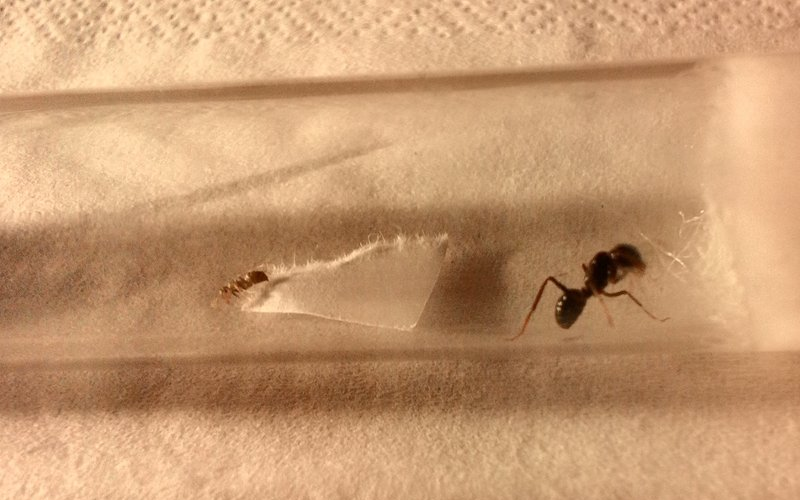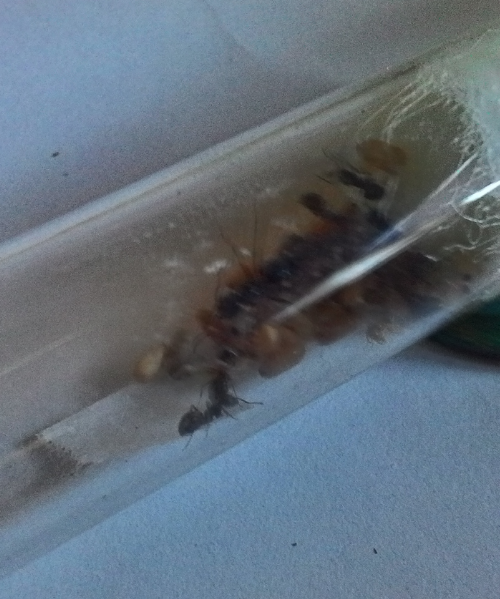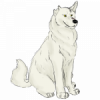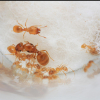Last week I caught some queen ants, and as I'm trying to start colonies with them, why not introduce them to you.
First I caught several Lasius niger queens - I won't be making any photos yet, I don't want to bother them now in the most crucial time of the colony founding - few of them unfortunately died in test tubes for no obvious reasons (no mold, no mites, no unnecessary attention through entire week since I got them... water also didn't dry off from the cotton plug... )
But those that survived now have eggs - and two oldest niger queens also seem to have larvae hatched already. I'm looking forward to see their colonies progress and I hope for no more deaths c:
From the claustral queens of mine, I also caught a single Lasius flavus queen - she didn't shed her wings though - but she started to lay eggs (hope she's fertilized and just lazy on the matter of shedding wings) - unfortunately, I must have bothered her too much, because she ate her first batch of eggs. I really hope she will lay again, I love these species and their golden coloured workers very much
But while Lasius niger is definitely something that almost every ant keeper in Poland has, because when they have their nuptial flight, they land literally everywhere and are impossible not to find, and Lasius flavus is a shy species that probably wouldn't tolerate too much attention in the early stages of colony founding, I also got something that is keeping me on my toes every day.
Last species of which i found queens are two Lasius fuliginosus queens. These species are also known as Dendrolasius or Jet black ants. European hyper-parasites, usually using colonies of another parasitic species, Lasius umbratus, as their hosts - fortunately I know some ant keepers who managed to successfully adopt them on L. niger workers and develop colonies - althought it is said to be very hard to do and those queens are prone to dying for no reason at any point of colony founding stages, or even after a colony was estabilished with a lot of Fuliginosus workers.
And yet I was tempted by the challange of this species, so I decided to try to raise a colony of them.
First queen that I found winged in the rain, unfortunately, died for no apparent reason after successfully adopting few L.niger workers and pupae.
Second queen, her royal highness Agricola, was caught wingless and later than the first Fuli queen, still lives though.
this is her soon after her capture:
This is her yesterday, when I introduced pupae to her and her adopted workers:

And this is how it looks today:
(I know the photos are blurred, but what can I say, I do not have the best photography equipment and there guys decided to move all the time when I was trying to shoot a photo of them :') )
As you can see, since yesterday population of adopted niger workers exploded, and more are on the way from the pupae.
As for how I introduced the first workers so they could open the pupae (her royal highness apparently can't do that, so I couldn't just go the easy way and shove pupae with the queen right away)
I used quite unconventional strategy - to not risk the injury of the queen, I never captured any wild niger workers - I only raided the pupae heating chamber in the niger nest and took about 50 pupae. then I picked out several of the darkest ones and attempted to open them, as delicately as possible, by myself. I admit it was risky for the young workers and part of them didn't survive, but from some pupae came lively, eager workers whom I introduced to the parasitic queen. Since they never encountered another ant of their birth colony in their imago lives, they just treated the parasitic queen as their mother right away, without any necessity for cooling them down. They gathered honeydrops for her and fed her and each other - that was the easy part. Later as I introduced the rest of pupae they started to open more and more cocoons, i hope to see a numerous army of host workers for my Fuliginosus queen.
Now the difficult part will be, to provide, somehow, the best possible environment for the queen to actually lay eggs and develop workers of her own species, without her suddenly dropping dead - but I know it is possible - so I will do everything in my ability to make it happen c:
Later today I will probably start working on the arena for them, so I will be able to give them protein food comfortably once the colony shall get large - and queen wille start laying eggs and hatching L. fuliginosus larvae c:
Edited by Adamantine, July 26 2018 - 6:26 AM.























